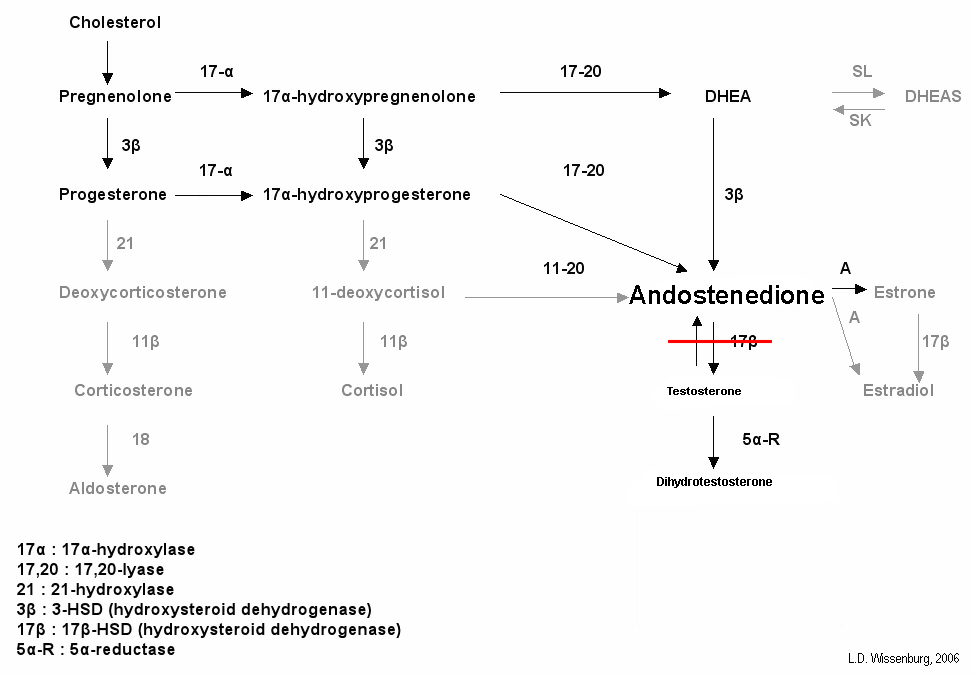17-beta-hydroxysteroid dehydrogenase deficiency pathophysiology: Difference between revisions
No edit summary |
Jose Loyola (talk | contribs) |
||
| (3 intermediate revisions by 2 users not shown) | |||
| Line 3: | Line 3: | ||
{{CMG}} {{AE}} {{Abdulkerim}} | {{CMG}} {{AE}} {{Abdulkerim}} | ||
==Overview== | ==Overview== | ||
17-beta-hydroxysteroid dehydrogenase deficiency-3 is [[biochemically]] characterized by decreased levels of [[testosterone]] and increased levels of [[androstenedione]] as a result of the defect in conversion of [[androstenedione]] into [[testosterone]]. | |||
==Pathophysiology== | ==Pathophysiology== | ||
17-beta-hydroxysteroid dehydrogenase deficiency-3 is [[biochemically]] characterized by | *17-beta-hydroxysteroid dehydrogenase deficiency-3 is [[biochemically]] characterized by; | ||
*Decreased levels of [[testosterone]]. | |||
*Increased levels of [[androstenedione]] as a result of the defect in conversion of [[androstenedione]] into [[testosterone]]. | |||
*This leads to clinically important higher ratio of [[androstenedione]] to [[testosterone]]. | |||
[[Image:Test biosynth 17BHSD3.jpg|thumb|center|600px| Biochemical effects of 17β-hydroxysteroid deficiency-3 in testosterone biosynthesis. Typically levels of androstenedione are significantly increased, whilst testosterone levels are decreased, leading to male [[undervirilization]].]] | [[Image:Test biosynth 17BHSD3.jpg|thumb|center|600px| Biochemical effects of 17β-hydroxysteroid deficiency-3 in testosterone biosynthesis. Typically levels of androstenedione are significantly increased, whilst testosterone levels are decreased, leading to male [[undervirilization]].]] | ||
=== Genetics === | === Genetics === | ||
| Line 16: | Line 20: | ||
[[Category:Endocrinology]] | [[Category:Endocrinology]] | ||
[[Category:Genetic disorders]] | [[Category:Genetic disorders]] | ||
[[Category:needs english review]] | |||
Latest revision as of 07:44, 20 October 2022
|
17-beta-hydroxysteroid dehydrogenase deficiency Microchapters |
|
Differentiating 17-beta-hydroxysteroid dehydrogenase deficiency from other Diseases |
|---|
|
Diagnosis |
|
Treatment |
|
Case Studies |
|
17-beta-hydroxysteroid dehydrogenase deficiency pathophysiology On the Web |
|
American Roentgen Ray Society Images of 17-beta-hydroxysteroid dehydrogenase deficiency pathophysiology |
|
FDA on 17-beta-hydroxysteroid dehydrogenase deficiency pathophysiology |
|
CDC on 17-beta-hydroxysteroid dehydrogenase deficiency pathophysiology |
|
17-beta-hydroxysteroid dehydrogenase deficiency pathophysiology in the news |
|
Blogs on 17-beta-hydroxysteroid dehydrogenase deficiency pathophysiology |
|
Directions to Hospitals Treating 17-beta-hydroxysteroid dehydrogenase deficiency |
Editor-In-Chief: C. Michael Gibson, M.S., M.D. [1] Associate Editor(s)-in-Chief: Abdulkerim Yassin, M.B.B.S[2]
Overview
17-beta-hydroxysteroid dehydrogenase deficiency-3 is biochemically characterized by decreased levels of testosterone and increased levels of androstenedione as a result of the defect in conversion of androstenedione into testosterone.
Pathophysiology
- 17-beta-hydroxysteroid dehydrogenase deficiency-3 is biochemically characterized by;
- Decreased levels of testosterone.
- Increased levels of androstenedione as a result of the defect in conversion of androstenedione into testosterone.
- This leads to clinically important higher ratio of androstenedione to testosterone.

Genetics
17-beta-hydroxysteroid dehydrogenase deficiency-3 is caused by gene mutations found in the 17BHSD3 gene. 17-beta-hydroxysteroid dehydrogenase deficiency-3 is an autosomal recessive disorder.